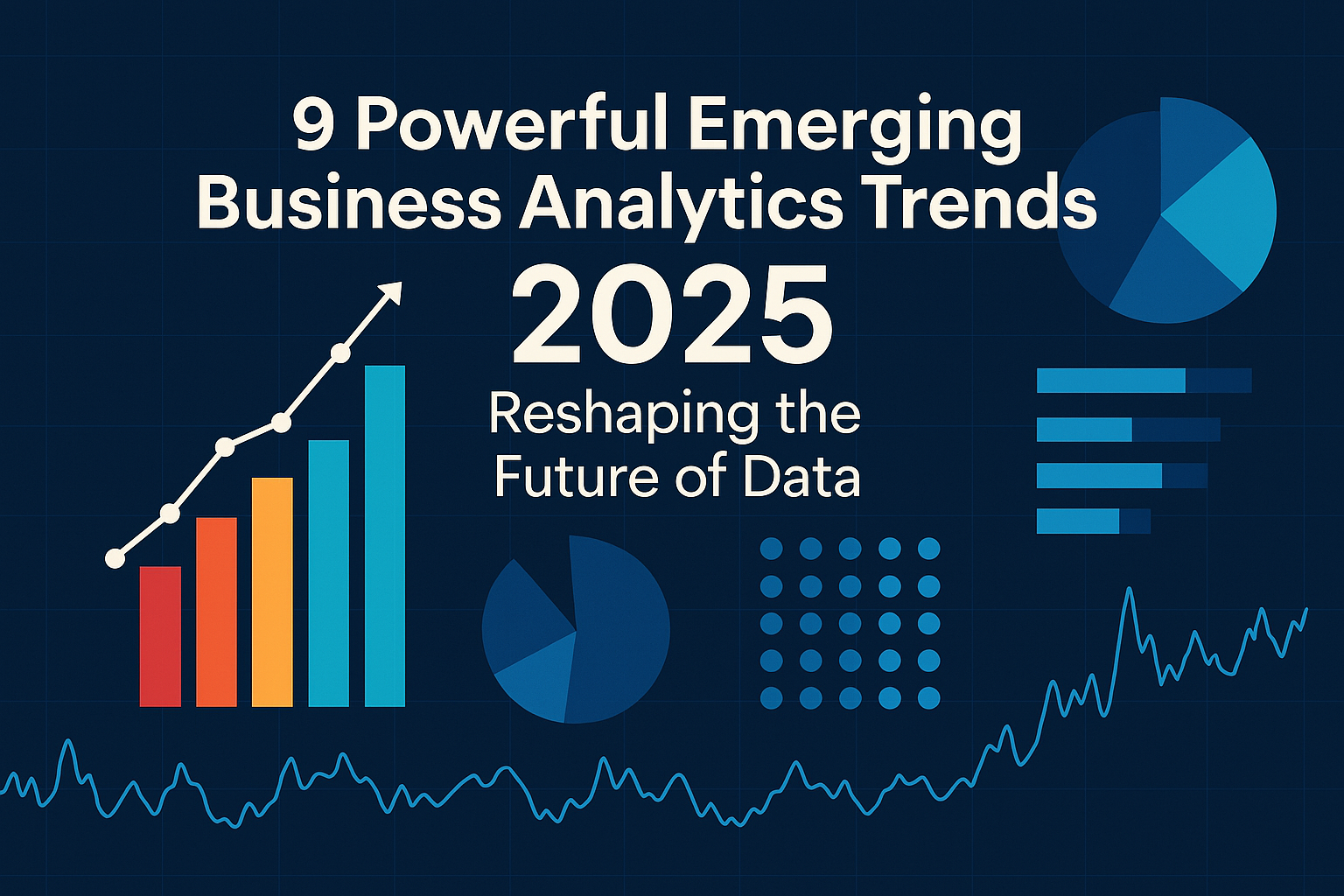
I’ve been tracking emerging business analytics trends 2025, and you won’t believe how transformative these positive shifts have become in reshaping data-driven decision-making. Have you ever wondered why data is often called the new oil? In 2025, this comparison feels more relevant than ever.
Today’s business landscape rewards agility, and companies that adapt fast—using data wisely—are winning. In this article, I’ll walk you through 9 jaw-dropping trends redefining the world of analytics this year. Whether you’re a data newbie or a seasoned strategist, there’s a trend here calling your name.
1. AutoML Goes Mainstream
Automated Machine Learning (AutoML) tools like H2O.ai and Google Cloud AutoML are no longer a luxury—they’re becoming essential. With intuitive interfaces and reduced coding requirements, even non-tech teams are building models that forecast customer churn, detect fraud, and optimise logistics.
I still remember the first time I used AutoML—fumbled a few settings, nearly lost hours of work, but the thrill of watching the model hit 87% accuracy was unforgettable.
➡️ Learn more from H2O.ai’s open-source AutoML technology and how it’s driving enterprise adoption.
➡️ Curious about how small teams can use AutoML? Here’s a practical breakdown from Pegon Academy.
2. NLP Is the Heartbeat of Customer Experience
Natural Language Processing (NLP) lets you listen to your customers—literally. Instead of pouring through reviews manually, companies are mining support tickets, emails, and social media to uncover powerful emotional insights.
One client of mine ran sentiment analysis on customer emails and discovered their “happy” customers were actually frustrated—just polite.
➡️ For practical implementation tips, explore Google Cloud’s NLP suite.
3. Real-Time Analytics Is the New Normal
As customers expect answers now, real-time analytics is emerging as a competitive must. Whether it’s fraud detection in banking or supply chain management, businesses are moving away from batch reporting to live dashboards.
At my previous role, we cut reporting lag from 6 hours to 2 minutes using a Kafka-based streaming platform. It changed everything—from inventory restocking to customer support.
4. Edge Analytics Is Here and Growing
With edge computing, data is processed locally—right on IoT devices, manufacturing equipment, or retail sensors. This means faster decisions and lower latency, especially in critical environments.
Last summer, I saw a factory diagnose and fix 11 machine anomalies in real-time without internet access. No cloud, no wait.
➡️ Read this case study on how Microsoft is enabling edge analytics.
5. Immersive Data Visualisation with AR and Voice
Dashboards are becoming dynamic. From augmented reality (AR) interfaces to voice-controlled analytics, users now ask their data questions and get real-time visual responses.
I once asked, “Which store had the highest foot traffic last Saturday?” and saw the answer pop up as a hologram. Wild.
➡️ To master this, check out our article on Data Visualisation Best Practices.
6. Workflow-Embedded Analytics
Nobody wants to jump between 7 tabs. In 2025, the smartest companies are embedding analytics right inside their everyday tools—Slack, Microsoft Teams, CRM platforms.
At my firm, we built a Slack bot that gives daily sales insights right into the channel. Zero clicks. Just results.
➡️ Salesforce Einstein Analytics is a prime example of embedding insights into workflow tools.
7. Ethical AI and Governance Frameworks
This trend isn’t flashy—but it’s critical. With greater power comes greater accountability. Ethical AI is about fairness, transparency, and avoiding biased outcomes.
I once found a model discriminating against rural customers—not intentionally, but through proxy variables. Governance caught it. Without it, we could’ve faced a PR nightmare.
➡️ McKinsey’s report on building responsible AI offers a robust framework for data leaders.
8. Data Democratisation & the Rise of Citizen Analysts
It’s not just analysts driving insights anymore. Citizen analysts—everyday employees using low-code tools like Power BI or Tableau—are now solving real business problems without ever writing code.
I watched a non-technical colleague build a live inventory dashboard on a Sunday afternoon. No joke. And it worked flawlessly.
➡️ Learn how to join the movement with Citizen Analytics 101 by Pegon Academy.
9. Predictive ESG Analytics: Profit with Purpose
Businesses are using analytics to tackle ESG (Environmental, Social, Governance) goals—optimising energy use, ethical sourcing, and sustainability metrics with predictive modelling.
We implemented a model that cut energy costs by 17% and reduced emissions. It wasn’t just smart—it was right.
➡️ Explore the World Economic Forum’s ESG insights to see what global leaders are doing.
What You Should Do Next
So, what’s your next move?
✅ Pick one trend—maybe start with NLP or AutoML
✅ Choose a low-risk pilot project
✅ Use free or open-source tools for fast experimentation
✅ Measure and document results
✅ Scale gradually and ethically
These emerging business analytics trends 2025 aren’t futuristic anymore—they’re happening all around you.
➡️ If you’re serious about analytics, why not explore more articles from Pegon Academy’s business and data analytics blog? There’s a lot more where this came from.
Final Thoughts: Data is Human
Let me tell you something honest. The best analytics projects I’ve worked on didn’t just solve business problems—they connected people. They told stories. They changed how we think, act, and grow.
So don’t just collect data. Feel it. Understand it. Use it to build something meaningful.
If you’re ready to start, Pegon Academy’s full Business Analytics Learning Track is a great first step. I highly recommend it—especially if you want to future-proof your career.
Quick Recap
- AutoML is now usable by anyone—not just data scientists.
- NLP uncovers deep, emotional customer insights.
- Real-time analytics helps make decisions instantly.
- Edge computing processes data at the source.
- Immersive visualisation creates rich data experiences.
- Embedded analytics integrate insights into daily workflows.
- Ethical AI ensures fairness and compliance.
- Citizen analysts are solving business problems.
- ESG analytics align profit with purpose.
